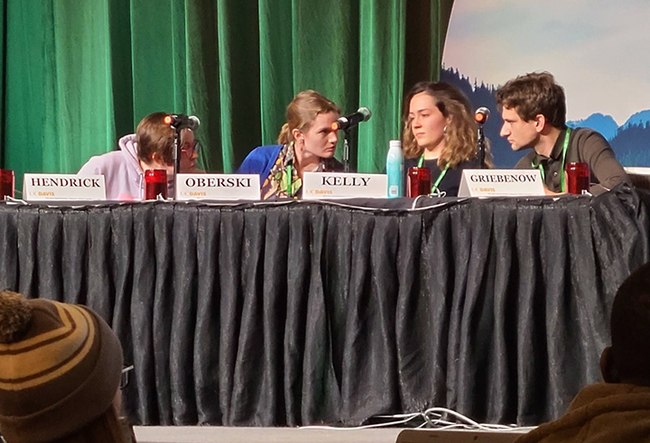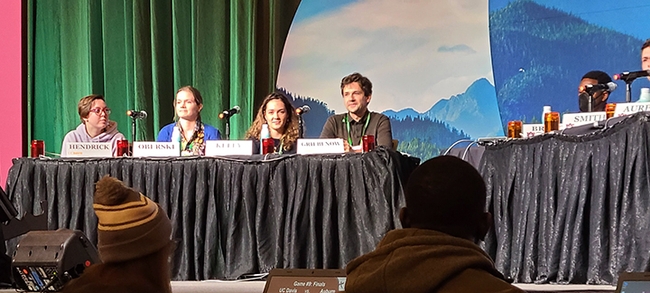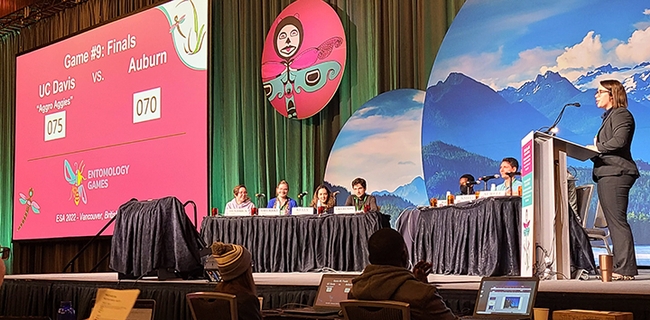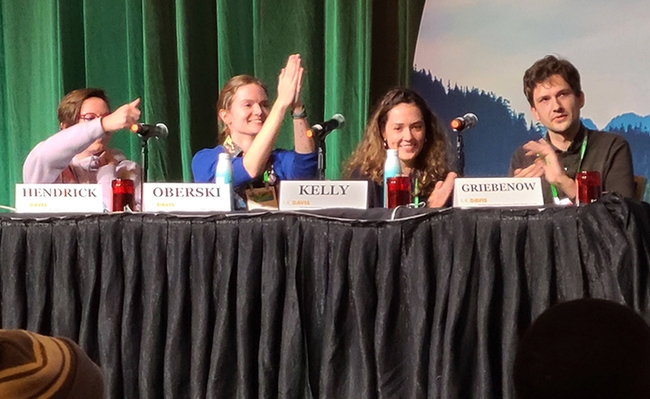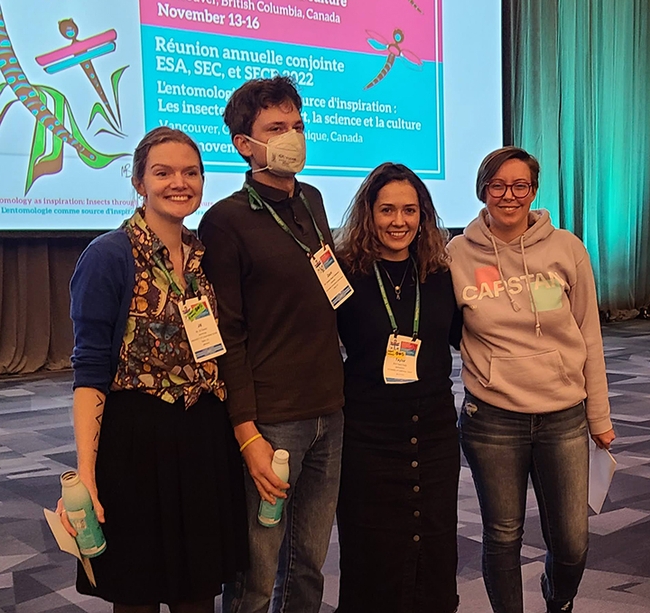- Author: Kathy Keatley Garvey
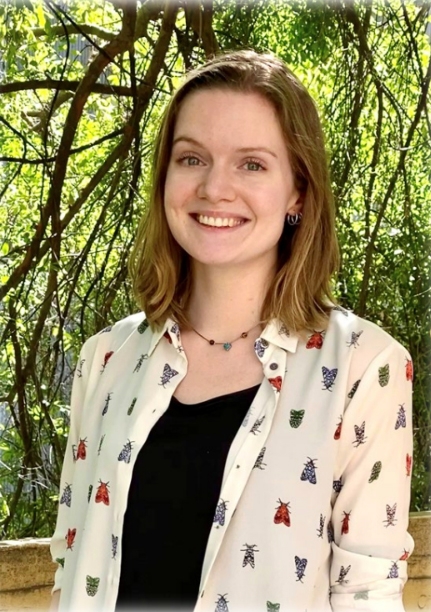
The seminar also will be on Zoom. A pre-seminar coffee will take place from 3:30 to 4:10 p.m. in 158 Briggs.
"Ants of the genus Dorymyrmex, the 'pyramid ants,' exhibit an intriguing distribution that is most concentrated not near the equator, but instead in dry temperate regions of the Americas, such as deserts, shrublands, and beaches, and including Davis, California," Oberski writes in her abstract. "Although these ants are common, widespread, and ecologically significant, their diversity and evolutionary history are still poorly understood. My dissertation research introduces Dorymyrmex to modern phylogenomics and concerted biogeographic study by integrating classic and cutting-edge approaches: I performed targeted genomics with UCEs, inferred Bayesian phylogenies and fossil-calibrated divergence dates, and also employed traditional methods like morphometrics and visual species description."
"My work (1) characterizes the major lineages of Dorymyrmex, which are morphologically diverse in the Neotropics but actively peciating (and superficially similar) in North America; (2) illustrates an intercontinental range expansion that occurred millions of years ago; and (3) characterizes the Nearctic fauna, nearly doubling the number of Dorymyrmex species in North America. Ultimately, this research contributes to our knowledge of both local biodiversity and global dispersal patterns, and reveals Dorymyrmex is a unique system for studying rapid evolutionary radiations."
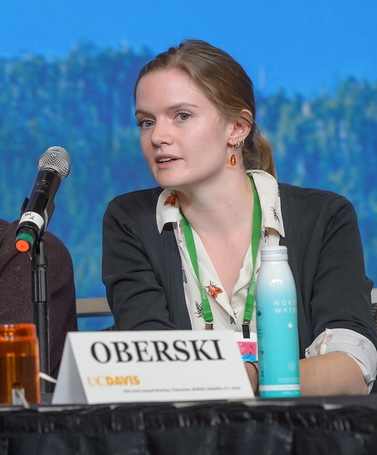
"I've been fascinated by insects as long as I can remember," Jill said. "As a kid, I learned the names of the major taxonomic orders and created a small pinned collection, but I didn't realize it could be anything more than a hobby, so I shifted my sights toward becoming a medical doctor. But when I went to college, I met a professor who actually does study biodiversity and discover new arthropod species for a living. So after getting my start in research at Macalester College, and a year as an intern at University of Wisconsin-Madison, I started searching for suitable research programs across the country where I could train as a grad student doing those same things—biodiversity, evolution, and biogeography of insects or arachnids."
"I was open to almost any insect/arachnid study system because generally, the more I learn about a group, the cooler I find it, and that turned out to be very true for ants. They're amazing little underappreciated creatures with societies all their own, and I'm so happy to be a myrmecologist."
Oberski is a past president of the UC Davis Entomology Graduate Student Association, and served in leadership roles in the Girls' Outdoor Adventure in Leadership and Science (GOALS).
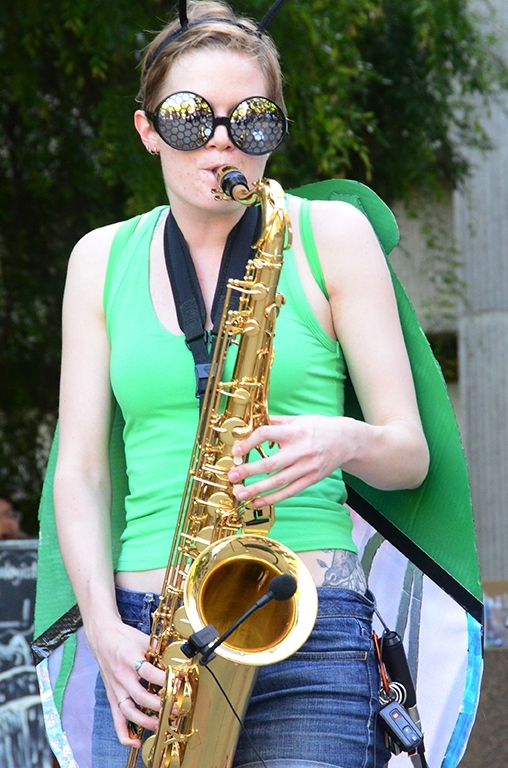
Oberski received a five-year Dean's Distinguished Graduate Fellowship award in 2017. In May of 2022, she was selected for a Professors for the Future Fellowship (PFTF) award, described by PFTF as "a year-long competitive fellowship program designed to recognize and develop the leadership skills of outstanding graduate students and postdoctoral scholars who have demonstrated their commitment to professionalism, integrity, and academic service. The program is designed to prepare UC Davis doctoral students and postdoctoral scholars for an increasingly competitive marketplace and a rapidly changing university environment." For her project, she recorded a series of interviews about mental and chronic illnesses and how they impact academic professional development.
Oberski, who plays tenor saxophone at community events, performed in an entomology band at the 2018 UC Davis Picnic Day as Jill “Jillus Saximus” Oberski. She dressed as a “generalized heteropteran,” which she described as “most likely a member of the family Acanthosomatidae (shield bug) or Pentatomidae (stink bug). My family and friends have called me Jillybug, so I came to be the band's representative of Hemiptera.” (See news story on Entomology website, and feature in Entomology Today, published by ESA)
Future plans? After receiving her doctorate on June 15 in a UC Davis ceremony, Oberski will be moving to Washington, D.C. this summer for a brief stint as a visiting researcher at the Smithsonian Museum of Natural History. Then, in January 2024, she will start a three-year independent postdoctoral research position in Frankfurt, Germany.
The Oberski seminar is the last of the spring seminars, all coordinated by urban landscape entomologist Emily Meineke, assistant professor. For technical issues regarding Zoom connections, she may be reached at ekmeineke@ucdavis.edu.
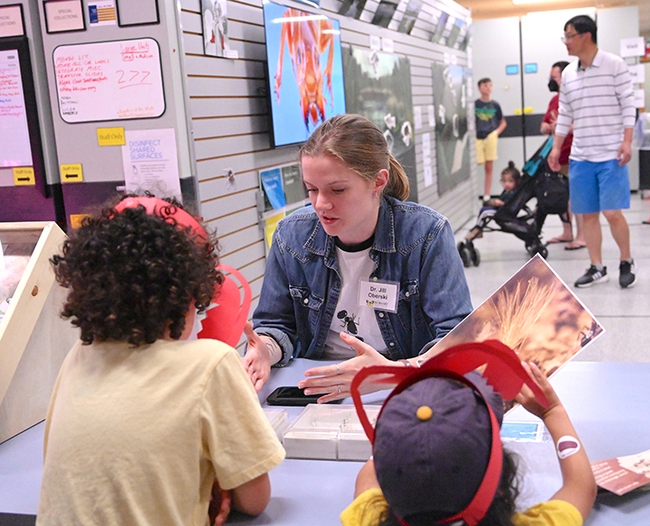
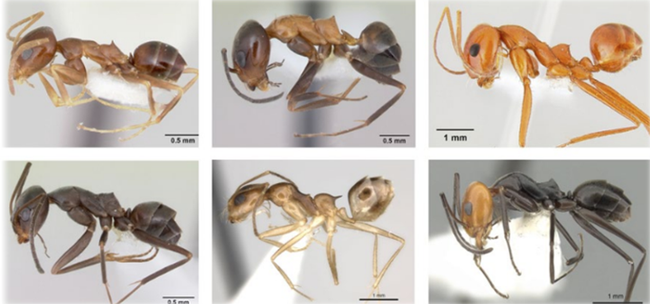
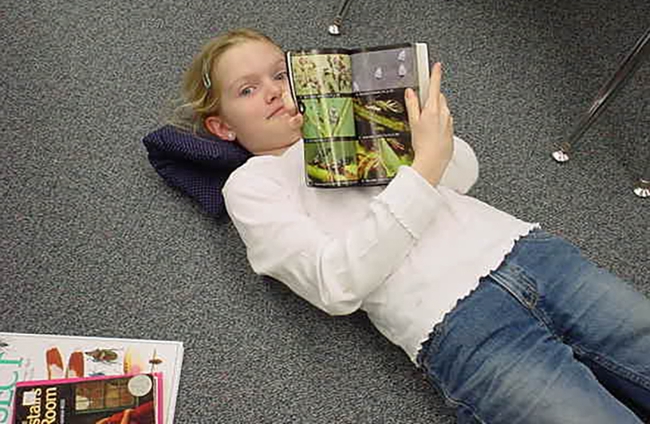
- Author: Kathy Keatley Garvey
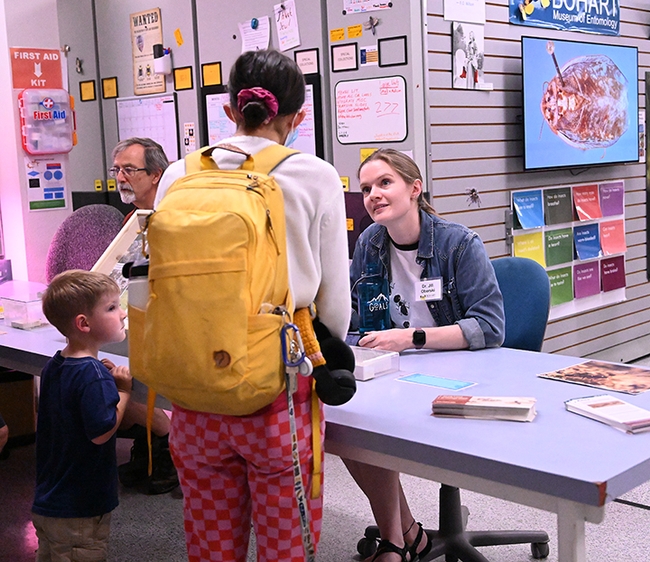
The three-hour open house included displays of live ants as well as specimens. Ward and newly minted PhDs, Jill Oberski and Zachary Griebenow of the Ward lab, fielded scores of questions. Oberski and Griebenow each wore a "Dr." name tag, presented by Tabatha Yang, Bohart Museum education and outreach coordinator.
"The questions were mostly about the habits and behavior of ants, how many species are there, etc.," Ward related. "And how can I obtain live colonies for my kid? I received almost no queries about 'how do I get rid of them in my kitchen?' and that was refreshing."
"We had live colonies of a centipede-hunting ant (Stigmatomma oregonense) and a generalist omnivore (Aphaenogaster occidentalis)," Ward said. "The displays also included collections of common California ants; the world's smallest ant (Carebara) and the world's largest ant (Myrmecia)."
Griebenow, who recently presented his exit seminar on "Systematic Revision of the Ant Subfamily Leptanillinae (Hymenoptera:Formicidae), Reciprocally Illuminated by Phylogenomics and Morphology," answered questions about his research, and general questions about ant diversity. Griebenow, who holds a bachelor of science degree (2017) in agriculture (entomology), magna cum laude, from The Ohio State University, joined the Ward lab in September 2017.
Oberski, who received her bachelor's degree in biology and a bachelor's degree in German studies (summa cum laude) in 2016 from Macalester College, Saint Paul, Minn., finished her dissertation earlier this month. She will present her exit seminar on "Phylogenetics and Biography of Pyramid Ants" at 4:10 p.m., Wednesday, June 7 in 122 Briggs Hall. It also will be on Zoom.
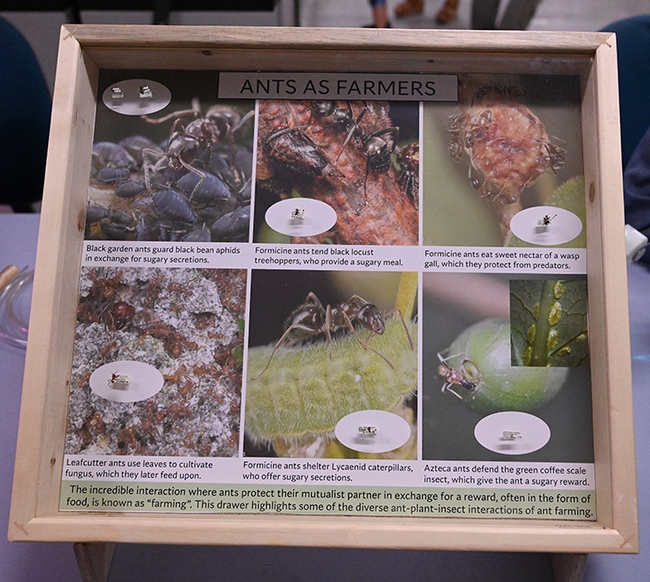
Questions at the open house? Oberski shared that she received "some great questions about ant diets. What do ants eat? Are ants specialized or generalized in their feeding habits? The answer can vary a lot. Some ants are generalists that eat any food they come across, but others are extremely specific, like ants that are fungus farmers or specialized predators of springtails, spider eggs, or centipedes."
Professor Ward is featured in a Bohart Museum of Entomology video on YouTube at https://youtu.be/d8eRNsD8dxo. Ants, he related, originated about 120 million years ago (early Cretaceous), evolving from "wasp-like creatures." They are members of the order Hymenoptera, and their closest relatives include honey bees, cockroach wasp and the mud daubers. California is home to some 300 species of ants, but thousands more live in the tropics. Globally, there may be as many as 40,000 to 50,000 species of ants, the professor estimated, but only about 14,000 are described.
Also in the video, Ward related that ants live in long-lived colonies with (1) cooperative brood care (2) overlapping generations and (3) reproductive division of labor, the hallmarks of eusocial behavior. He also pointed out:
- A typical ant colony contains a reproductive queen, numerous non-reproductive workers and brood (eggs, larvae, pupae)
- Colonies of ants can be thought of as superorganisms: tightly integrated and cooperative entities with complex systems of communication and division of labor (castes)
The Bohart Museum, directed by UC Davis distinguished professor Lynn Kimsey, houses a global collection of eight million insects and also maintains a live "petting zoo" (Madagascar hissing cockroaches, stick insects, tarantulas and others) and an insect-themed gift shop. The museum is located in Room 1124 of the Academic Surge Building, 455 Crocker Lane.
The next Bohart Museum open house, themed "Insects and Forensics," will be from 1 to 4 p.m., Saturday, June 3. It will feature forensic entomologist Robert "Bob" Kimsey and his work.
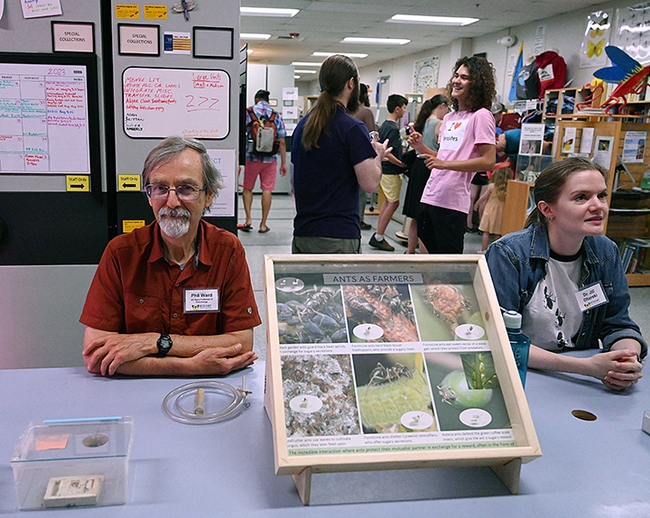
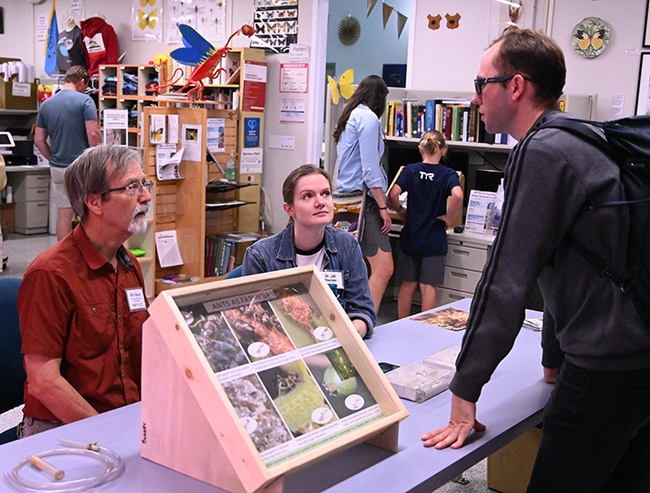
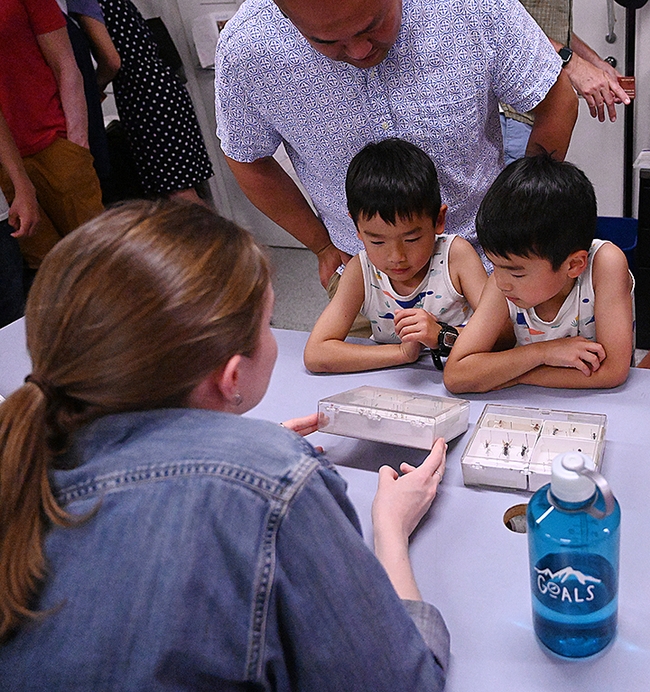
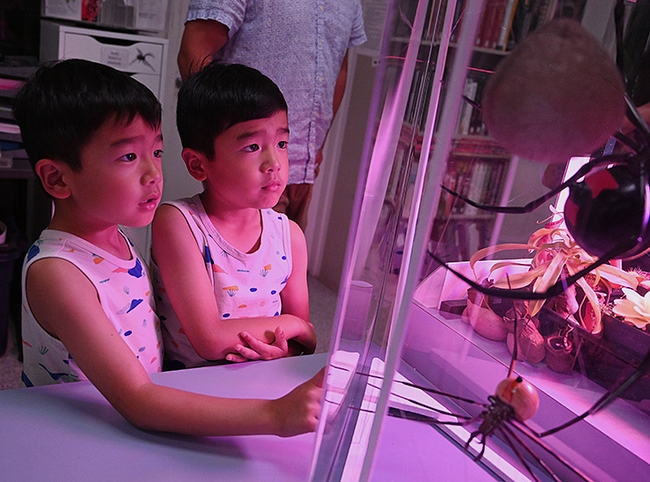
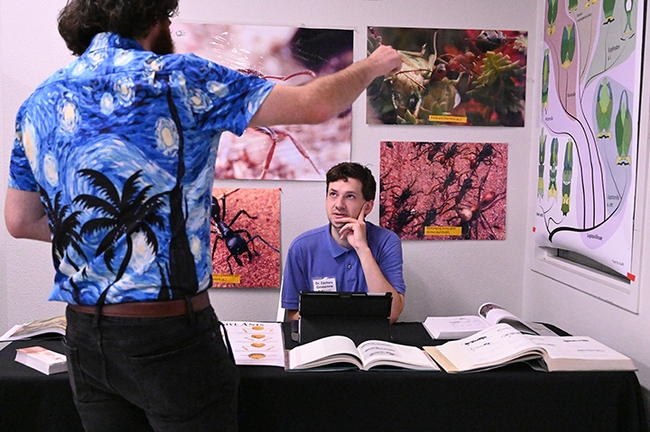
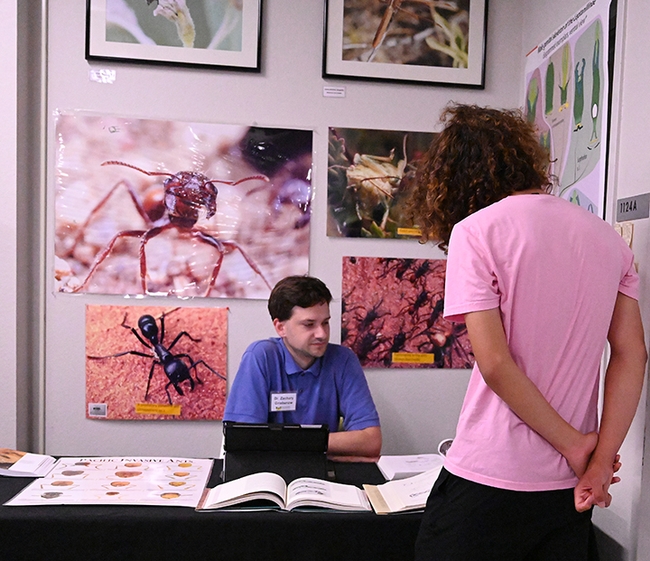
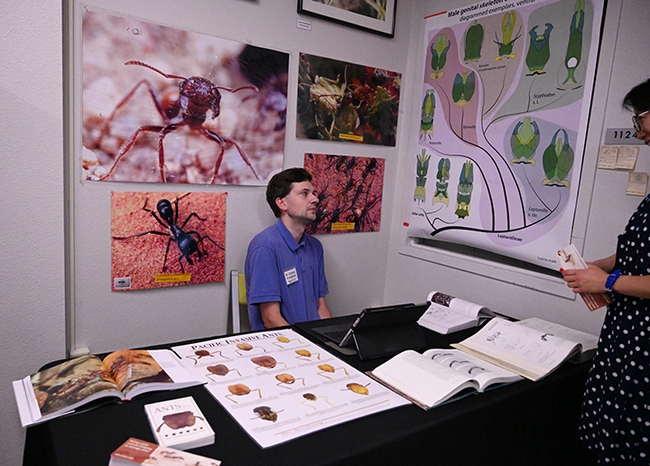
- Author: Kathy Keatley Garvey
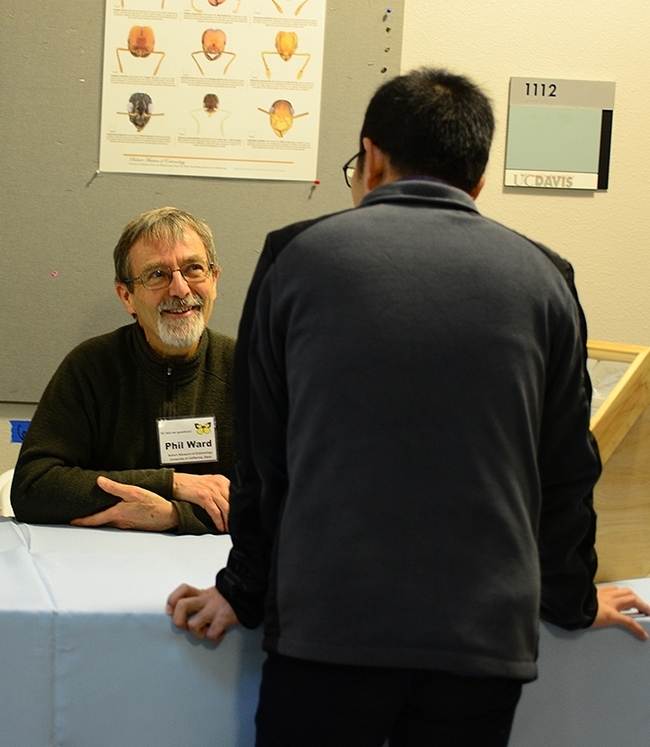
The laboratory of Professor Phil Ward, UC Davis Department of Entomology and Nematology, will provide live ants, specimens, information, and engage in one-on-one discussions about ant species at the Bohart Museum of Entomology open house from 1 to 4 p.m., Sunday, May 21.
The event, free and family friendly, will take place in Room 1124 of the Academic Surge Building, 455 Crocker Lane. The family arts-and-crafts activity will be to create paper ant headbands. "The current version has serrated mandibles, but people can go free form, too," said Tabatha Yang, education and outreach coordinator. "We're hoping for a colony of visitors with red headbands."
Among the Ward lab scientists scheduled to participate are doctoral candidates Jill Oberski and Zach Griebenow (both are expected to receive their PhDs this year), and third-year doctoral student Ziv Lieberman.
Griebenow and Oberski are veterans of UC Davis teams that won national championships in the Entomological Society of America's Entomology Games or "Bug Bowls." (See news story) UC Davis teams won national championships in 2022, 2018, 2016 and 2015.
The Bohart Museum featured Ward, a noted ant systematist, in a video, "All About Ants II" shown at the 2021 UC Davis Biodiversity Museum Day. It is posted on YouTube at https://youtu.be/d8eRNsD8dxo.
Ward offered an hour-long, introductory presentation on ants and answered scores of questions, drawing viewers from as far away as Virginia. He illustrated his talk with ant images taken by his former doctoral student Alex Wild (PhD from UC Davis in 2005), curator of entomology at the University of Texas, Austin, and a noted macro photographer (http://www.alexanderwild.com).
Ants originated about 120 million years ago (early Cretaceous), evolving from "wasp-like creatures," Ward said. They are members of the order Hymenoptera, and their closest relatives include honey bees, cockroach wasp and the mud daubers.
Ward related that live in long-lived colonies with (1) cooperative brood care (2) overlapping generations and (3) reproductive division of labor, the hall marks of eusocial behavior. He also pointed out:
- A typical ant colony contains a reproductive queen, numerous non-reproductive workers and brood (eggs, larvae, pupae)
- Colonies of ants can be thought of as superorganisms: tightly integrated and cooperative entities with complex systems of communication and division of labor (castes)
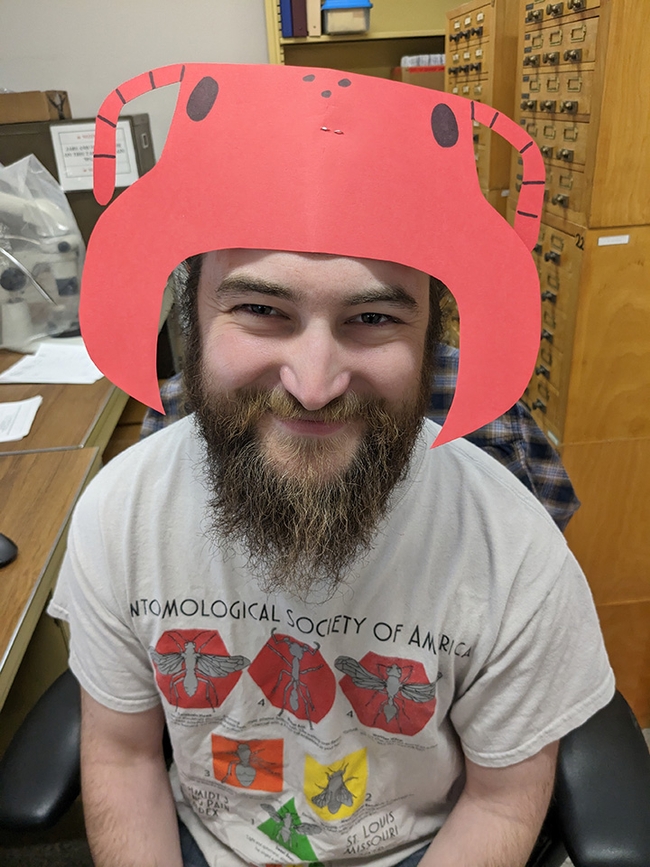
"Ants have occupied almost all of the world's land surfaces, from deserts to rain forests," Ward said in the video. "There's a few places they're absent. They're not in Antarctica, no surprise! They haven't colonized the Arctic and a few very high elevation tropical mountains, but apart from that, almost any place you go on land you'll see our friends, the ants. And they have assumed a quite a diverse array of ecological roles. Some of them are predators, others are scavengers, and some are seed collectors, and these habits vary tremendously among different species in different parts of the world."
Ants communicate largely by chemical (pheromones) and tactile means, Ward said. Their vision is "not particularly acute." He pointed out that that they lay a trail pheromones from the source of food back to the nest. They have alarm pheromones, causing other workers to act defensively. Chemicals also help ants distinguish their nest mates.
Some ants, like the Argentine ants, are pests. These invaders from South America "form super colonies, which means different colonies don't fight each other; they're all cooperating. And the other downside of Argentine ants is that they tend to eliminate native ants. So over the years I've lived in Davis, I have certainly noticed that native ants have declined as the Argentine ants have expanded. And they expand not just in, say, urban areas, but along certain natural habitats and one that they really like is the riparian habitat. So if you look along rivers and streams that are near urban areas, they're getting invaded by Argentine ants. And when they do, most native ants just disappear. This is a very tough aggressive ant and the mellow California ants can't handle an aggressive invader from South America. So they just disappear."
The Bohart Museum, directed by UC Davis distinguished professor Lynn Kimsey, houses a global collection of eight million insect specimens, plus a petting zoo (including Madagascar hissing cockroaches, stick insects and tarantulas) and a gift shop, stocked with insect-themed t-shirts, hoodies, jewelry, posters, books, and collecting equipment.
Founded in 1946, the Bohart is open to the public Mondays through Thursdays, from 8 a.m. to noon, and 1 to 5 p.m. More information is available on the Bohart website at https://bohart.ucdavis.edu or by emailing bmuseum@ucdavis.edu.
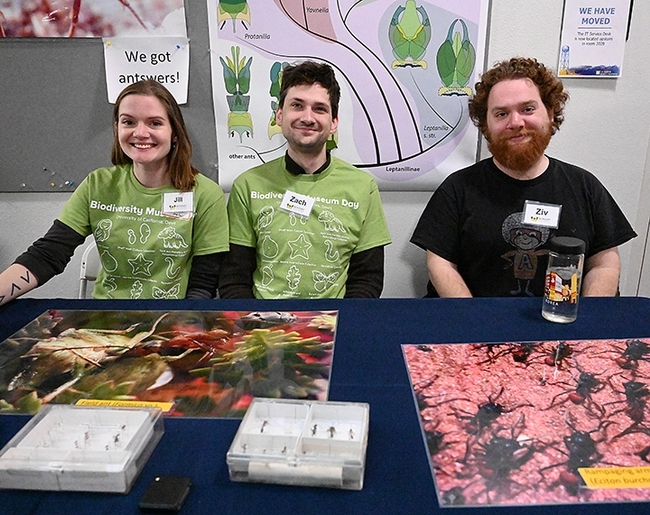
- Author: Kathy Keatley Garvey
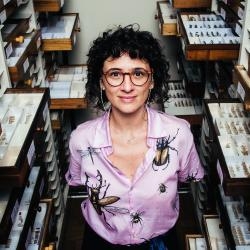
Brazilian-born scientist Mônica Antunes Ulysséa, a postdoctoral fellow in the laboratory of Corrie Moreau, Cornell University, will speak on "Morphology for Assessing Species Diversity and Previously Unknown Biological Traits of the Ant Genus Hylomyrma" at a virtual seminar at 4:10 p.m., Wednesday, Dec. 7.
The Zoom link: https://ucdavis.zoom.us/j/95882849672. Host is doctoral candidate Jill Oberski of the Phil Ward laboratory.
"Hylomyrma is a Neotropical ant genus of small to midsized ants, cryptic inhabitants of the leaf-litter of wet and dry environments, with a remarkable body sculpture," she says in her abstract. "They occur from sea level to 3,600m, from Mexico to northern Argentina and southern Brazil; its higher diversity is in the Amazon. Out of the 30 recognized species, 11 have females whose external morphology combines morphological traits of workers and queens, and at least three of them present female specimens with queen-like traits. These mosaic specimens sent me back to fieldwork to investigate more about the genus biology. I went to Serra do Cipó, Brazil, to find nests of the endemic Hylomyrma primavesi. Hence, for the first time, the H. primavesi nest architecture and the colony size were documented, the ergatoid queen, male and immatures were collected, and the behavior of the forage workers and their feeding preferences based on field and lab observations were recorded."
Ulyssea specializes in myrmecology, taxonomy, phylogeny, systematics, curatorial practices, and science dissemination. She received a 2018-2023 postdoctoral fellowship at Zoology Museum of University of Sao Paulo (2018-2023) to study in the Moreau lab. Professor Moreau, who teaches arthropod biosystematics and biodiversity, directs and curates the Cornell University Insect Collection.
Ulyssea's resume includes:
- Doctorate from the Zoology Museum of University of Sao Paulo, Brazil, Graduate Program in Systematics, Animal Taxonomy, and Biodiversity (2013-2017)
- Internship at Sorbonne University, Pierre and Marie Curie Campus, Paris/France (2015-2016).
- Master's degree in zoology, Graduate Program in Zoology at the State University of Feira de Santana, BA/Brazil (2010-2012).
- Bachelor and licentiate in biological sciences at Federal University of Santa Catarina, Florianópolis, SC/Brazil (2002-2008)
Urban landscape entomologist Emily Meineke, assistant professor, coordinates the department's seminars. This is the last of the fall seminars. For further information on the seminars or technical difficulties with Zoom, contact Meineke at ekmeineke@ucdavis.edu.
- Author: Kathy Keatley Garvey
The UC Davis Entomology Games Team edged out Alabama's Auburn University 75 to 70 to win the national championship at the Entomological Society of America's Entomology Games, waged Tuesday night, Nov. 15 at the ESA meeting in Vancouver, British Columbia.
This is the fourth national championship for UC Davis since 2015.
The 2022 UC Davis team was comprised of four doctoral candidates from the Department of Entomology and Nematology: Zachary Griebenow of the Phil Ward lab, captain; Jill Oberski of the Ward laboratory; Erin “Taylor” Kelly of the Geoffrey Attardo lab; and Madison “Madi” Hendrick of the Ian Grettenberger lab.
"The 2022 Entomology Games were once again a highlight of the ESA Annual Meeting for students in entomology from all over the country," said Games Committee chair Meredith Spence Beaulieu, university program manager of Global One Health Academy, North Carolina State University. "My fellow members of the Entomology Games Committee and I congratulate the University of California, Davis, team on their victory, and we commend all the teams and students who participated this year."
The highly anticipated event is a lively question-and-answer, college bowl-style competition on entomological facts played between university-sponsored student teams. The question categories are biological control, behavior and ecology, economic and applied entomology, medical, urban and veterinary entomology, morphology and physiology, biochemistry and toxicology, systematics and evolution integrated pest management and insect/plant interactions.
Among the questions (paraphrased) asked at the Entomology Games:
- The principal blood sugar of insects is a disaccharide called what? Answer: Trehalose.
- All Neuroptera pupate within shelters spun from silk produced by what anatomical structure? Answer: Malpighian tubules
- In 1973 Dr. David Gibby of the Washington State University Extension Center started a program to meet the demand for urban horticulture and gardening advice, which has since expanded to all 50 states and 8 Canadian provinces. What is the name of this program? Answer: The Master Gardeners' Program

In the finals, the Auburn team was comprised of Dan Aurell, Chelsia Smith and Dylan Brown. In the preliminary round, Alan Jeon also competed with them.
The student-quiz event, launched in 1982, was formerly known as the Linnaean Games but the ESA Board of Directors changed the name in July of 2020 to "Entomology Games." Students compete first at an ESA branch level, with each branch sponsoring the winning team and runner-up at the nationals. UC Davis won the championship at the Pacific Branch in April. UC Riverside placed second.
The ESA meeting, themed "Entomology as Inspiration: Insects Through Art, Science and Culture," opened Nov. 13 and continues through Nov. 16. It is a joint meeting with the Entomological Society of Canada and the Entomological Society of British Columbia.
The Entomology Games championship match video will be posted soon on ESA's YouTube channel. The full bank of questions will be loaded on this site. The previous UC Davis championships:
- 2018: The University of California team (UC Davis/UC Berkeley) defeated Texas A&M. Members of the UC Team: captain Ralph Washington Jr., then a UC Berkeley graduate student with a bachelor's degree in entomology from UC Davis; doctoral students Brendon Boudinot, Jill Oberski and Zachary Griebenow of the Phil Ward lab, and doctoral student Emily Bick of the Christian Nansen lab.
- 2016: UC Davis defeated the University of Georgia. Members of the UC Davis team: captain Ralph Washington Jr., Brendon Boudinot and Emily Bick.
- 2015: UC Davis defeated the University of Florida. Members of the UC Davis team: captain Ralph Washington Jr., and members Brendon Boudinot, Jessica Gillung and Ziad Khouri.
Founded in 1889 and located in Annapolis, Md., the 7000-member ESA is the world's largest entomological organization. It is affiliated with educational institutions, health agencies, private industry and government. Members are researchers, teachers, extension service personnel, administrators, marketing representatives, research technicians, consultants, students, pest management professionals, and hobbyists. The 2022 president is evolutionary biologist Jessica Ware, associate curator of invertebrate zoology at the American Museum of Natural History, New York.
Resources:
- Listen to the 2018 Entomology Games (won by the University of California team, comprised of three UC Davis graduate students and one UC Berkeley students who is a UC Davis alumnus), posted on YouTube (audio only, no video)
- Watch the 2016 National Linnaean Games Championship Round (won by UC Davis), posted on YouTube
- Watch the 2015 National Linnaean Games Championship Round (won by UC Davis), posted on YouTube
